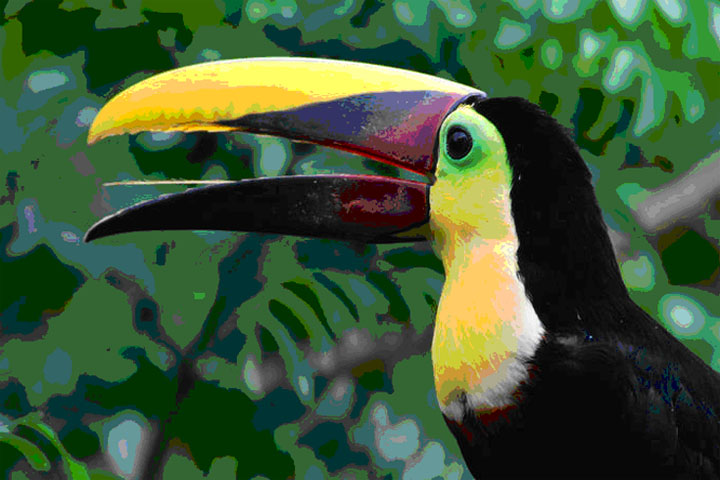|
|---|
Jungle Birds - A Chestnut Mandibled Tucan - What a Show Off! |
Broken News
What's to Say?
Here's what Christmas/New Year's time looked like in much of the northern U.S.:
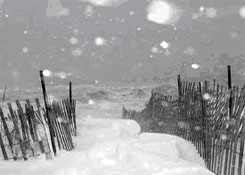 |
 |
 |
|---|
And here's what it looked like here:
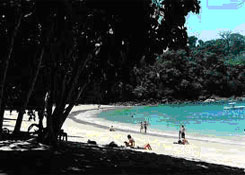 |
 |
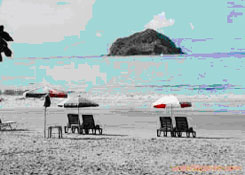 |
|---|
What's to say amigos? Is everyone enjoying the change of seasons? (Sorry my chilly amigos, I couldn't resist)
More on Manuel Antonio the Man
The Chronicles featured an article in the December 2012 edition entitled "Who is Manuel Antonio?".
GG was surprised to learn how little is known about the origin of the man whose name is borne by the most visited park in Costa Rica. And this is true for locals as well as tourists and the travel industry. One popular myth is that he was a conquistador buried in the park - not. Another was that he was a leader of an uprising that took back the park land in the late 1960's just before the government expropriated the area for the park. Yet another theory was Manuel Antonio was a sailor. These are both wrong too. (There is a hushed rumor he might have been no more than a squatter who lived in the area a long time - can't disprove this one so far).
The December article pointed out that a man named Manuel Antonio Ramirez is the most likely candidate for the namesake honor and a memorial to him has been constructed near the area known as Mar Y Sombra west of the park. There you'll find a closed nightclub that used to be called the Mar y Sombra and a restaurant right on the beach called "Balu".
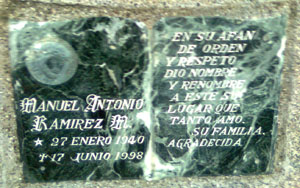 |
|---|
| The Ramirez Family Plaque Commemorating Manuel Antonio Ramirez |
However GG learned after publishing the previous article that the gentleman who still owns the Mar y Sombra, a personable amigo by the name of Federico Ramirez Muñoz, is actually the son of the man whose bust is portrayed at the nearby memorial. Upon learning this, the Chronicles sent its mobile news unit (guess who that is) to the scene to interview Senor Ramirez. Here's what our crack reporters learned:
-
The Ramirez clan first moved to the area now known as Manuel Antonio in 1948 to escape the turmoil in the country caused by the raging civil war. The patriarch of the clan was Octavio Ramirez, father of Federico and seven other sons. One of the sons, born in 1940, was Manuel Antonio Ramirez M. who was five years older than Federico and who went by the nickname "Balu". He owned the restaurant that still goes by his nickname and which is now run by his son who survived him.
- The population in the park area in 1948 was virtually nonexistent. the Ramirez tribe being among the first to settle there. The area was so remote in the late 1940's that United Fruit employees based in Quepos preferred to reach the beaches in and around the park by boat. In 1948, Balu was 8 years old and Federico was 3. The park area was later acquired in the 1960's by some French ex-pats who tried to control access to the beaches. This was a bad idea as there are no private beaches in Costa Rica by law. A small local revolt ensued (see original article "Who is Manuel Antonio?") that included Hernan, one of the Ramirez brothers. Shortly thereafter the current park site was expropriated by the government and designated a national park.
- The government was not totally without logic in naming the new park Manuel Antonio. The name had been widely used in referring to the area for years, even before the Ramirez clan came to the area. How it originally came to be known as Manuel Antonio is still unknown, hence the myriad of stories of its origin. One of the eight (8) Ramirez brothers, Danilo, went on to become a Diputado de Assemblea (a Deputy in the National Assembly - the equivalent of a U.S. Congressman) in the late 1990's but that was long after the park had been founded (1969) and named so it's likely he had no influence on either the founding or naming. The bust at the memorial near Mar y Sombra is of the Ramirez father Octavio and was erected by the government.
- The brother Manuel Antonio, or Balu, died in 1998 and the family erected a memorial plaque (picture above) adjacent to the memorial for his dad. They credit Balu, or Manuel Antonio Ramirez, for opening up the commercial aspects of an area that he loved so much. The inscription on the plaque reads: "In his urge to (give) order and respect, he gave his name and prestige to this place he loved so much - His Grateful Family". Frankly, adding the plaque is stretching it a bit and may be confusing the story if it leads to future historians thinking the area was named after Balu; it wasn't.
So the origin of the name Manuel Antonio, as it relates to the park, is still a mystery. Rest assured that the Chronicles crack investigation team has not yet finished with this story - a trip to the National Archives in San José is beckoning - more info will be forthcoming as it is available; stay tuned.
¡Pura Vida!
Bees Lead Call Outs
The Bomberos of Costa Rica (Firefighters) recently released their 2012 annual report on the types of call outs they had during the year. Here's a partial list - (below, left):
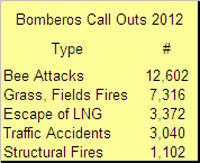 |
|---|
 |
|---|
| Killer Bee Nest Palo Verde, C.R. |
What, bee attacks were the biggest reason by far why firemen were called? Yup.
With all the bees in the jungle here, these stats are not surprising. And unfortunately, since about thirty years ago, the bee population here has included strains of killer bees that migrated from South America. There have been several deaths in Costa Rica in recent years as a result of bee attacks, including one in the Naranjito/Londres area about 15 miles from Quepos.
If you want to know the best way to avoid or survive a bee attack, check out this link: http://www.tucsonweekly.com/tw/07-04-96/outthere.htm. Basically, the suggested standard procedure is to run like hell for over a hundred years from the nest, a distance where it is believed the bees give up the chase (I would probably do 200 meters to be sure).
But, like most things in God's world, bees may have a negative side but they also have a (very) positive contribution to make as well. Check out the article below entitled "Mind Your Bee's Wax" to see what I mean.
Rumble Talk
(Happenings On Or About the Pacific Rim)
Double Down Under
The seismological center at the University of Costa Rica has published its annual report for 2012 and noted that the number of measurable tremors was more than double those of the previous two years.
 |
|---|
| CR Recorded Earthquakes in 2012. Looks Like a Bad Rash but Each Dot Represents a Measurable Earthquake |
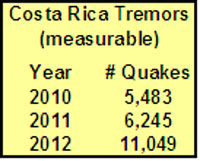 |
As of December 15th, the official count for 2012 was 11,049 and we could safely add another 20 or so that occurred in the last two weeks of the year.
Now the number they're talking about is the actual total number of tremors strong enough to register on the seismograph(s). The center also classifies something they call "felt" earthquakes which are those over 2.0 on the Richter scale. Using that cutoff, the number drops to 115 for last year, still much higher than recent years. It also includes the second strongest earthquake in Costa Rican history, the 7.6R monster in the Nicoya peninsula in September.
The term "felt" earthquakes sounds like something rather subjective to me. I know that I've personally become more sensitive to ground movements, particularly when I'm lying in bed not asleep. I can tell the difference between a heavy truck bouncing through the potholes of the street outside my apartment and the room gently taking on a feeling of liquidity or lightly shivering jello. I'll bet a lot of those are below the 2.0 "felt" threshold.
In terms of the "felt" earthquakes, there are historically on average five to seven instances per month but in September 2012, when we had the big one, there were 28, followed by 20 in October, and 21 in November. The number dropped sharply to six in December and continued to be moderate in January
Perhaps those dear old tectonic plate friends of ours, the Cocos and the Caribbean, have finally spent there energy for a while and we've entered a period of benign activity.
Let's hope so.
Nicaragua Too
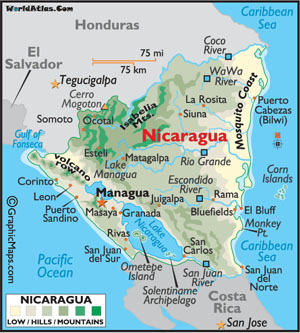 |
|---|
On September 9th last year. a few days after the Big Shaker in Costs Rica, the Pacific Rim relieved more pressure by erupting a volcano in Nicaragua.
The volcano in question was at San Cristobal, about 105 kilometers (60 miles) northwest of Managua as the toucan flies. The San Cristobal volcano is one of the youngest, geologically speaking, in Nicaragua and is situated in an area called "Volcano Row". Actually, there are five volcanoes alone in the San Cristobal collection.
The Volcanic Row region, as the name implies, is a very active area geologically and San Cristobal has a long history of eruptions, albeit most of them not as dramatic as the recent one. San Cristobal also happens to be the tallest volcano in Nicaragua at 1,745 meters or 5,700 feet.
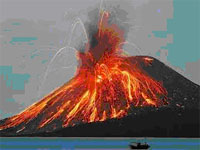 |
|---|
| Pretty at Night But Deadly |
See the map to the left for orientation. "Volcano Row" is clearly marked to the northwest of Managua if you don't have cataract problems like GG, otherwise it's hazily marked.
The recent eruption caused the evacuation of thousands living within five kilometers of the volcano. The ash and smoke plume during the day reached four kilometers high (two and a half miles). With every eruption came a number of aftershocks that were felt for hundreds of miles around. The lava flow at night was spectacular but, of course, extremely dangerous.
Hopefully, this activity also is diminishing with time, just like the Costa Rica earthquake count.
Growing Faith
(Living in the Word)
The Costa Rican Constitution lists Roman Catholicism as the official religion of the country. (Yeah, and the document also has a section that requires the government to spend no more than it takes in, a balanced budget amendment if you will. This year the government is operating at a 40% debt to expenditure ratio - I wonder how they skirted the constitution on that one?)
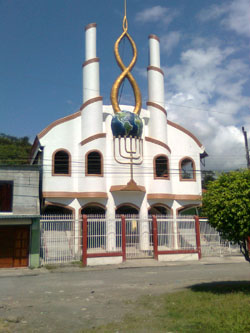 |
|---|
| La Luz Del Mundo |
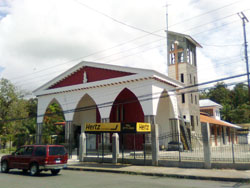 |
| Inmaculada Concepción Nearing Completion of Its Latest Renovation |
 |
| Inside Inmaculada Concepción Still Dressed for Christmas |
The constitution also plainly states that no restriction is to be placed on other religions, all may be practiced freely. Many other religions, mostly of a evangelical or fundamentalist protestant nature, have prospered here. In my neighborhood alone we have a Jehovah's Witness Kingdom Hall, a large and newly renovated La Luz del Mundo (Light of the World Church) and one more facility that I've yet to identify. Nevertheless , about three quarters of the population here still identify themselves as Roman Catholics.
We tend to think of the flock following the Church but often the Church has a need to follow the flock. So it was with our local RC Church, named Inmaculada Concepción. This is a bit of deja vú for me as my first parish growing up, where I went to grammar and high schools, was Immaculate Conception, Newburyport, Mass.
Located across the street from the east end of the Quepos football field, it's hard to miss the IC church because it's right at the end of the road from Manuel Antonio and at one of the busiest intersections in town.
So it was that in the early days of Quepos the Church established itself under the Spanish and by the Franciscans. They set up the first mission in the area in 1570 at the mouth of the Rio Naranjo (Orange River) about 10 miles south of the current Quepos and they named the mission San Bernadino. One of their goals was to convert the Quepoa indians which didn't happen to any significant degree.
Finally, in 1730, not long after the declaration of independence from Spain, the mission was abandoned. By that time, most of the Quepoa had been killed or scattered. The area entered a long period of benign neglect that lasted into the 1900's.
With the advent of the banana industry, the resulting growth of Quepos as a port and the increase in population in the area it was obvious there needed to be a permanent Church presence. Franciscans again came to Costa Rica in 1940 but this time from the U.S. They serviced Quepos from their home base in Alajuela with a priest that visited every three months who concentrated on baptisms and weddings. They used a small house located on the present site.
The growth of the parish continued through the morphing of the primary industries in the area, first bananas, then palm oil and in more recent years, tourism. Eventually, some permanent priests and friars were assigned to the Quepos parish. Sometime later the parish was turned over from the Franciscans to the Diocese of San Isidro and later transferred to the Diocese of Puntarenas where it remains today..
The current Church building was first built by MOPT, the Ministerio de Obras Publicas y Transportes(ministry of Public Works and Transportation) in the late 1960's. MOPT is a government agency but I guess when there is a national religion, the government has no qualms or legal restrictions about constructing buildings for citizens, even if they have a religious purpose. The facility has been renovated several times since it's initial construction.
One interesting thing that cropped up when I was writing this piece was that the project manager for the original building was one Antonio Chaves Cascante who happens to be the father of my Spanish teacher. Señor Antonio Chaves still lives in his hometown of Bagaces in the province of Guanacaste.and has reached the ripe old age of 98. (I'm not sure it was his good works, Gallo Pinto or Coyol but he's doing something right).
There's no doubt that this church and its people have contributed to the history and well-being of local life.
¡Solo Bueno!
End of the World
(And Other Non-Happenings)
Not to be caught short by any momentous event, a group of friends planned a party and gathered at Manuel Antonio beach on December 21 to celebrate the end of the world.
 |
|---|
| Classical Rendition of the Apocalypse |
The passage of this year's winter solstice was not quite as planned by the oracles, not nearly as dire as the self-appointed prophets would have it. It turned out to be just another incredibly gorgeous day at Playa Espadilla with full sun, air temperature in the high eighties, water temp in the low eighties and a slight, cool breeze blowing off the Pacific. It was rather difficult to get into an impending doom mind set under these conditions.
The end of the world myth grew out of past archaeological discoveries of Maya calendars, calendars that abruptly ended at the solstice this year. The last date on the calendars that had been discovered up until recently was December 21, 2012 (recorded as the year 5115 for the Maya - pikers; it's 5773 on the Jewish calendar).
Creative interpreters of dubitable information have suggested for a long time that this particular winter solstice would mark the end of the world because that's when the calendar ran out. Oh pshaw. More recently additional calendars were found in newly excavated caves that blew the theory apart when the dates went beyond the 2012 solstice (see Apocalypse Postponed).
 |
|---|
| Chichen Itzá, Guatemala |
The Maya had a direct connection to Costa Rica even though their empire was centered at Chichen Itzá in Guatemala. The empire, through many centuries of expansion and migration of descendants finally reached the Nicoya peninsula here, where the giant earthquake of September 2012 was centered. One could have taken that quake as an act portending the final doom; it seemed that way to me (see Terremoto Terror). The particular tribe of Maya that developed in the Nicoya were called Chorotegas; they also went by the names of Guatusos y Orotiñas (so that's where the name of the town of Orotina came from, eh). In this way, northwestern Costa Rica became the southern boundary of the Maya empire.
Even though we knew that the myth had been discounted recently, our group of pseudo-Maya aficionados decided to cover all our bases. We met at noon on the 21st on Playa Espadilla beach at the large log in front of Mar y Sombra on which is painted "Surfing Lessons". If you gotta go, surfing a 500 foot tsunami is as good a way as any. We voted down throwing a virgin into the fiery caldera of a volcano as a modern impracticality compounded by the expected difficulty in finding a qualified person in Costa Rica. Actually, the Maya threw people into a watery pit rather than a fiery volcano but the Pacific didn't seem to us to fit the need either and most of us were already swimming anyway. Instead, we decided on having only a simple Maya prayer service at noon.
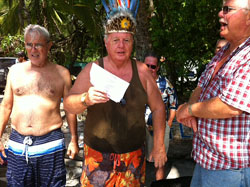 |
|---|
GG After Having Just Been Installed as Cacique del Dia |
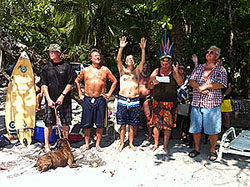 |
The End of the World Group - Part I in Midst-Solstice Prayer - Where Did All the (Smart) Women Go? |
GG, because of his extensive experience as a shaman in a previous life, was chosen cacique (cah-see-kay or chief) for a day and outfitted with the appropriate headdress (see picture). That's sort of like being queen for a day, but that's probably not a good analogy to use in Manuel Antonio. The authentic headdress was that of an indian chief's from Ecuador with a headband made of jaguar pelt (hold the anti-fur letters please) and containing multi-colored feathers.
The solstice prayer we used is called the "Prayer of the Seven Directions" and involves the penitents facing the four directions of the compass and calling on the Great Spirit: the House of Light (East) for awakening of wisdom, the House of the Night (North) for ripening of wisdom, the House of Transformation (West) for converting wisdom to right action and the House of Eternal Sun (South) for the harvesting of the fruits of right action.
The other three directions are the House of Heaven (above) where star people and ancestors gather, the House of the Earth (below) at the crystal core and the House of the Centre which is everywhere at once and where everything may be known (I want an office there please).
The final Maya ceremonial prayer goes like this:
Oh Yum Hunab Ku Evam Maya E Ma Ho
(
All Hail the Harmoney of Mind and Nature)
One could pray for worse things. (And, after all, we did hold off on the virgin sacrifice thing, didn't we?) The ceremony concluded within an hour and, somewhat disappointed at missing the apocalypse, we went to lunch. So GG's first end of the world experience in Costa Rica ended pretty much as just another great day on this globe.
And now December 21, 2012 can take its place on the historical and hysterical list of broken myths right behind Elizabeth I of England's virginity and Y2K.
¡Sólo Bueno!
Própolis
(Mind Your Bee's Wax)
Sometimes I think I'm the last person to know about anything.
Recently I decided to nurture a bad cold, or gripe (pronounced gree-pay here) so that I wouldn't pass a full year without that invaluable experience. It arrived one afternoon with that tell-tale tickle settling in the nose that confirms it's an airborne attack and trumpets the inevitable and irreversible progression towards flu-like symptoms. Or at least I thought it was irreversible.
 |
|---|
The ailment followed it's usual progression from tickle the first day to total blockage of the right side of the head, including sinuses, the second day, a jump to the left side of the head the third day and finally a drop into the chest the fourth day. All of this was happening while large plastic bags of used kleenex were being hauled to the trash daily. I have always been amazed at how much mucous the human body can produce during one of these episodes (hope you're not eating lunch when you read this).
It's the drop into the chest that always concerns me because I have a weak bronchial system (couldn't have anything to do with 20 years of cigarette smoking followed by 25 years of cigars - fortunately nothing for almost four years now - naw, couldn't be that). I take several medicines to compensate for the bronchial and related heart weaknesses but our local pharmacist will not give me a booster shot of Vitamin B12 or high strength antibiotics for the flu because of the other medicines I take.
So it's a grin and bear it situation, and the four days following the drop to the chest during this new episode were hell. GG was almost continuously coughing, often a dry cough, while trying to loosen the tight chest with that old standby, Vick's Vaporub, which wasn't very effective at all on this particular bug. Sleeping was sporadic at best and it seemed like the problem was going to last forever.
 |
|---|
| Commercial Version Containing Própolis |
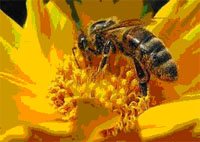 |
| Bee-have Amigo |
 |
| Própolis Patch in a Hive |
 |
| Brusha, Brusha, Brusha |
Then a Tico friend suggested I get a product called Propóleo, an all-natural remedy said he. Feeling frustrated and a little desperate, I proceeded to the macrobiotica store in the central market of Quepos. The product was offered both as a spray and in a small jar as a thick liquid. I bought the latter for 4,000 colones as I couldn't figure out why or how I would use the spray, my throat wasn't sore.
I started taking Propóleo in the afternoon of day 8 and got in two spoonfuls that day. I was pleasantly surprised at how good it tasted. The thick liquid is essentially natural bee honey with other stuff in it. I haven't tasted medicine that good since my mom used to give me Father John's Medicine as a boy (you older dudes will remember that stuff).
The very next day I started to feel better. By day 10, two days after I started taking Propóleo, the cold was well in remission with only a little congestion remaining. I continued to take the remedy for the next couple of days and began sleeping well again, further destroying the bug, whatever it was. I've never had such a dramatic result with a cold medicine before. So what is this stuff? The GGC research staff (guess who that is) geared up and went to work to learn more.
The two major ingredients listed on the Propóleo bottle are 1) natural bee honey and 2) própolis. So the magic ingredient is própolis, eh? Própolis turns out to be a resin-like material, sticky at room temperature, that honey bees collect from the buds of poplar and other cone-bearing trees that have sap flows and also from certain kinds of tropical flowers. The worker bees use própolis, along with bee's wax, to patch their hives and reduce the number of entry points to the hive for protection against predators. It varies in color depending on the local flora sources but usually is dark brown.
Turns out that própolis has been used since ancient times (nobody told GG). The Greeks used it for abscesses, the Assyrians to heal wounds and tumors and the Egyptians even used it for mumification (hmmm, maybe for next year's Maya ceremony we could also do a mummification with própolis).
The literature is filled with reports, some clinically backed, some not, that própolis has been effective for cankers, colds, swine flu, peptic ulcers, herpes and cold sores, burns (hence the spray version) and oral diseases. This latter use may be why Colgate introduced a toothpaste containing própolis.
But how and why does it work? More than 50 different chemical ingredients in própolis have been identified and they vary from locale to locale, as mentioned before, depending on the flora from which the stuff is extracted by the bees. But scientists have discovered natural anti-biotic and anti-fungal components in própolis which are probably the most important healers in the mix. Whatever goodies it has, própolis worked for me and the next time the gripe invades I'll be going for a fresh bottle of Propóleo at the Macrobiotica. (I wonder who the first dude was who had the gonads to carve into a beehive to collect a bunch of this stuff?)
So that should have been the end of the story about bees but it wasn't. For some time now (two months?) I've had an increasing level of pain in my upper left arm. At one point I went to the hospital emergency room (the fastest way to get national health care service here) and had them check me out. EKG and blood electrolytes were all normal. They suggested it was muscular and sent me home with ibuprofen. It was then I remembered the muscle strain may have come from my trying out some new exercises called The Five Tibetans earlier and perhaps I over did it. (Exercise can be injurious to your health amigos)
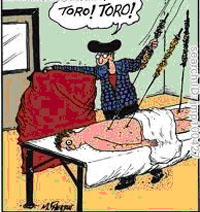 |
|---|
| Acupuncturist Ralph Had Always Dreamed of Being a Great Bull Fighter |
The pain continued and about a week after the gripe incident had passed I decided to try something else for relief. Living and working literally around the corner from me is a Chinese medicine/acupuncturist dude. I had been to him once before when he relieved some arm weakness related to the congestive heart failure I was going through. This time he probed my shoulder with his fingers and after the appropriate grunts and moans in Mandarin, he pronounced it a muscle prawlum, using a interesting Chinese/Spanish/English accent.
Next he produced a small tool that looked like a dentist's pick except it was blunt on the end. He proceeded to push this probe, rather painfully I might add, into several places on the palm and back of my hand and on three spots on my shoulder. Then he pulled out a small brown bar, about the size of a baby firecracker, and I began to wonder if he was still celebrating New Year's like many other Ticos in Quepos and was going to try to blow the pain away. He also pulled out a cigarette lighter and began melting the bar onto the points he had bruised with the probe, again with significant pain from the process. (Wax burns can hurt amigos)
"Wazzat stuff?" asked GG. "Parafina de abeja, señor". Bee's wax. After completing the process and resting prone on the table for about fifteen minutes the pain in my arm was not totally eliminated but definitely greatly mitigated. My Chino-Latino amigo sent me away feeling much better and with instructions on how to massage my left earlobe to help the arm muscle. I don't ask why anymore, I just do.
So for the second time in a month, GG was helped by natural products coming from our little buzzing buddies.
Son of a bee, good stuff.
¡Pura Vida!
What's-in-a-Word
Growing Your Brain
More and more evidence is emerging that learning a second language is beneficial to your health (that is, when it's not driving you crazy).
The latest is a report from the Swedish armed forces interpreter academy in Uppsala (ya, Roly, da Sveedes did it nah) . They took the trouble of measuring physical changes in the brains of students before and after they took the course. The intense course at the academy lasts 13 months and produces fluent speakers in a number of languages such as Arabic, Russian or Dari (Afghan).
Tis true the people normally attending the academy, because of their chosen field of study, have a "flair for languages" but the study also used a control group of medicine and cognitive science students from a nearby university. Both groups were serious students who studied hard, the only difference being the control group did not study languages. Here's what they found:
-
"While the brain structure of the control group remained unchanged, specific parts of the brain of the language students grew. The parts that developed in size were the hippocampus, a deep-lying brain structure that is involved in learning new material and spatial navigation, and three areas in the cerebral cortex."
This is Elsa. Elsa Studied Too Long at the University at Uppsala but Now Speaks 27 Languages
-
The amount of growth in the brain areas was greater for those that studied harder and had developed superior language skills. (my mom always said this)
Other research reports released recently have concluded that bilingual and multilingual people on average have a later onset of Alzheimer's. (I hope I can remember that). A very recent study at the University of Kentucky College of Medicine “...found that seniors who are bilingual are able to activate their brain with a magnitude closer to young subjects," (yeah, baby, muy bien!)
Ta mig till din ledare, önskar jag att tala med honom! (Sweedish for "Take me to your leader, I wish to speak with him!)
ROMEO Corner
(Retired Old Men Eating Out)
L'Angolo - Quepos
Location: The busiest intersection in Quepos one block from the bus station across the street from
Dos Locos
Hours: Lunch and Dinner Six Days a Week (closed Mondays)
Parking: On-street only.
Contact: Tel.: Not Available (Just Walk In)
Reviewing ROMEOS: Brian M., Jim M., Bob N., Tim D.
To Review Our Rating System and Procedure, go here: R.O.M.E.O. Rating System
L'Angolo has been around quite a few years and continues to put out excellent food chiefly because it's owner/chef, a gent hailing from Rome itself, pays a great detail to it's preparation and presentation. It may be also the only restaurant in the area that's air conditioned, which is particularly appreciated because it 's a small place and because it's in the center of Quepos.
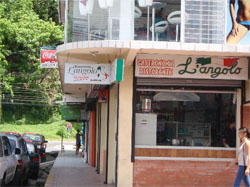 |
|---|
This is a plain restaurant with wooden chairs accented in cast iron and some benches lining the walls. There are only about six or seven tables with a maximum seating capacity of about 20. The walls are decorated simply with some photos of well known Italian actors such as Sophia Loren and some others not so well known. The net result is to give the place a mini-bistro effect.
The restaurant also includes a deli with Italian specialties like prosciutto and Italian cheeses available for purchase.
The menu is surprisingly extensive for a small place and includes various antipasto combinations and several bruchettas and carpaccios for starters. I was kind of hoping for a real Italian soup like minestrone or wedding soup but couldn't find soups on the menu. L'Angolo offers a wide range of sandwiches on Italian bread that could.keep one busy sampling for a dozen lunches. The menu also includes a large number of pasta combinations with meat, seafood or vegetables. The listing also includes pizza.
Two ROMEOS decided to start with bruchettas, one with gorgonzola and one slathered with pesto. The pesto version was very tasty as I presume the other was by the way it was gulped down. For the main course I chose a tortellini putanesca, little hand made pasta turnovers stuffed with finely ground meat and covered with a light red sauce containing small bits of bacon, garlic, thinly sliced mushrooms and black olives. Simply delicious. Another ROMEO had his pasta with bolognese sauce and was also impressed. Still another ROMEO had a simple tossed salad with balsamic vinegar and olive oil and pronounced it fresh and tasty. A fourth member joined us late and had a penne pasta in a cream sauce. Same positive reaction as the other ROMEOS. |
 |
|---|---|
$ $ $ $ |
|
Value Index = 100 |
While the latecomer was dealing with his penne pasta, yours truly had a tiramisu that was the only desert offered that evening and which was very creamy, sweet and nicely chilled.
Even by Tico standards, one must admit the service at L'Angolo is slow. Almost every time we visit there someone remarks on this but we keep coming back. Opinion: the reason it's slow is because the owner/chef picks over every plate and he often is the only one in the kitchen. And the quality of the food makes one forgive the tardiness in the service. For atmosphere, food quality and service we give L'Angolo an overall rating of four strong sloths (actually, I've never met a weak sloth).
As usual, GG had the most food and the biggest bill. For three courses, the bruchetta, the tortellini and the tiramisu, along with three cokes, my bill came to a little over 14,000 colones, about $27. This is not cheap but on the high end of typical for the area (four $) and reasonable for this quality of food. Four sloths and four $ puts the restaurant right in the middle of our value index.
L'Angolo is probably the most authentic Italian restaurant in the area and always a good food experience. If you haven't tried it yet, you should have it on your restaurant bucket list for munching or dining.

